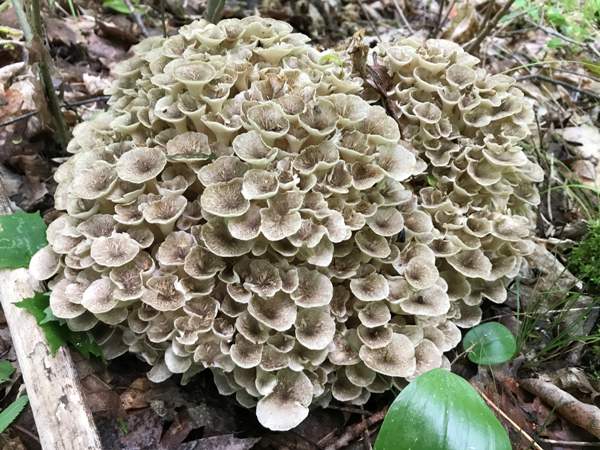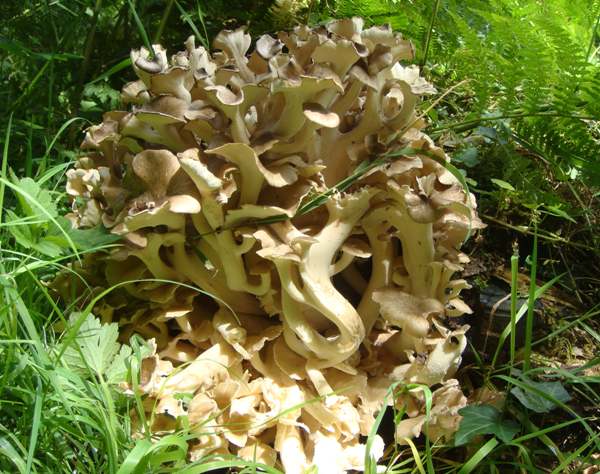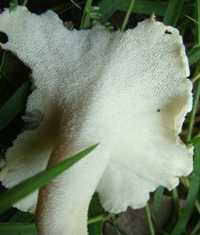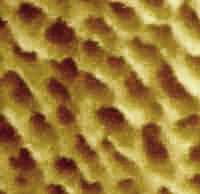Trees Birds Mammals Fish Amphibians Reptiles
Wild Algarve
Bookshop
Polyporus umbellatus (Pers.) Fr. - Umbrella Polypore
Phylum: Basidiomycota - Class: Agaricomycetes - Order: Polyporales - Family: Polyporaceae
Distribution - Taxonomic History - Etymology - Identification - Culinary Notes - Reference Sources

Above: Umbrella Polypore in broadleaf woodland, Canada
Much less common than the related species Grifola frondosa, which is known as Hen of the Woods,
the fruitbodies of the Umbrella Polypore Polyporus umbellatus are fairly short-lived; they occur as fungal rosettes at the bases or on large underground roots of deciduous hardwood trees, and most often on oaks.
This fungus
is parasitic and attacks living trees, causing a white rot. Trees can live for several years with this fungal infection, and so fruitbodies may recur for a number of seasons.
The Umbrella Polypore shown above was found in Ontario, Canada, while the rather darker specimen pictured below was growing at the base of an old oak tree in the New Forest, Hampshire, England.

The Umbrella Polypore shown above was found in Bedfordshire, England.
Distribution
Rare in Britain, where it is mainly confined to southern England, this large and distinctive polypore occurs also in parts of mainland Europe and in many regions of North America.
Taxonomic history
In 1801 Christiaan Hendrik Persoon described this massive polypore, giving it the binomial scientific name Boletus umbellatus. In his Systema Mycologicum of 1821 the great Swedish mycologist Elias Magnus Fries transferred this species to the genus Polyporus, thereby establishing its currently-accepted scientific name Polyporus umbellatus.
Synonyms of Polyporus umbellatus include Boletus umbellatus Pers., Sclerotium giganteum Rostr., Grifola umbellata (Pers.) Pilát, and Dendropolyporus umbellatus (Pers.) Jülich
Etymology
The specific epithet umbellatus may be interpreted as 'having umbrellas', but another slightly different interpretation that more closely matches the shape of the branch tips is 'having a central depression - an umbilicus, like a navel'.
Identification guide
 |
Fruitbody
The whole fruitbody can be up to 50cm in diameter; it comprises a thick fleshy basal stem that branches repeatedly with terminal branches ending in shallowly-funnelled caps with thin, wavy margins.
Caps
The individual caps are initially greyish brown covered in fine fibrils or small fibrous scales. The caps, which have white flesh when young, turn ochre and then brown as they age. |
 |
Tubes and Pores
The fertile undersurface of the cap comprises shallow tubes typically 1 to 1.5mm deep and usually
rounded; they terminate in pale cream angular pores spaced at typically 1 per mm and decurrent to the
stem. |
| |
Spores
Cylindrical, smooth, 7.5-10 x 3-3.5μm; inamyloid.
Spore print
White. |
Odour/taste |
Pleasant sweet odour when young; less so when
decaying. The taste is initially sweet, ultimately becoming acrid when the fruitbody is fully grown and begins to decay. |
Habitat & Ecological role |
Parasitic, at the bases of oak trees and other hardwoods. This fungus may also feed for some time as a saprobe after its host tree has died. |
Season |
Summer and autumn. The fruitbodies decay rapidly and do not persist through the winter. |
Similar species |
Grifola frondosa, Hen of the Woods, is more common; its fruitbody has terminal branches that end in fan-shaped or leaf-like fronds rather than rounded umbels.
The Umbrella Polypore could possibly also be confused with the much paler Wood Cauliflower Sparasis
crispa, but that species grows only at the bases of conifers and most
frequently Scots Pines.
Meripilus giganteus often forms rosettes at tree bases or from underground roots, but its fronds are much thicker and its main host is Beech. |
Culinary Notes
Although it is an edible fungus, this polypore it is so rare that it should not be collected for eating.
Reference Sources
Fascinated by Fungi, 2nd Edition, Pat O'Reilly 2016, reprinted by Coch-y-bonddu Books in 2022.
BMS List of English Names for Fungi
Dictionary of the Fungi; Paul M. Kirk, Paul F. Cannon, David W. Minter and J. A. Stalpers; CABI, 2008
Taxonomic history and synonym information on these pages is drawn from many sources but in particular from the British Mycological Society's GB Checklist of Fungi.
Acknowledgements
This page includes pictures kindly contributed by Hugh Purvis and Cathy Wills.
Top of page...
Fascinated by Fungi. Back by popular demand, Pat O'Reilly's best-selling 450-page hardback book is available now. The latest second edition was republished with a sparkling new cover design in September 2022 by Coch-y-Bonddu Books. Full details and copies are available from the publisher's online bookshop...